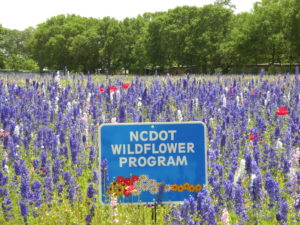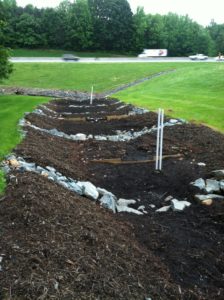The science behind improving stormwater quality has advanced in recent decades. Stormwater research provides a mechanism to improve the understanding of the pollutants in stormwater, their impacts on receiving streams, and the Best Management Practices (BMPs) that can be used to mitigate or avoid those impacts. Today, a well-developed stormwater management plan is not satisfied solely through the reduction of peak flow via a large detention basin. Stormwater research projects provide state and local agencies with the information they need in order to 1) correctly identify the root causes of the problem and 2) implement the most cost-effective solutions that will solve the problem. In general, many stormwater research projects seek to answer the question, “How much can this new idea improve the quality of water downstream?”
New BMPs such as level spreaders and vegetated filter strips allow stormwater agencies to choose from a larger selection of water quality improvement tools. Ongoing research provides information on the pollutant removal effectiveness of various BMPs, as well as recommendations for design, site selection and prioritization, installation techniques for contractors, and frequency of maintenance activities. Research at the state or local level further engages the community by creating partnerships between universities and stormwater agencies.

The City of Burlington is leveraging its current membership on North Carolina’s Water Resource Research Institute Stormwater Group in order to access opportunities that align with the needs of Little Alamance Creek watershed. The City of Burlington is in the process of developing a new research relationship with Elon University, a partner in the community. Under its NPDES stormwater permit, NCDOT implements a Research and Development Program which works closely with the UNC system of universities, the United States Geological Survey, and other experts in the field of stormwater management.
Through the two current research programs, numerous stormwater or water quality-related studies and projects have been conducted since 1999. Both research programs solicit new research ideas through a competitive selection and funding process. Where opportunities materialize, pilot projects or case studies can be directed to Little Alamance Creek watershed, potentially providing site-specific monitoring and implementation of pollution controls. The addition of Elon University as a future research partner enhances the project partner’s capability to identify more site-specific research opportunities in the Little Alamance Creek watershed.
NCDOT conducts a wide variety of research on how to improve existing stormwater controls or to better determine what pollutants may exist in runoff. NCDOT-funded stormwater research ideas have included:
- Roadside vegetated swales

- Soil infiltration
- Biofiltration conveyance
- Permeable pavement research
One of the most common methods to improve stormwater, are roadside swales, which allow runoff to flow into the soil. New research on how to design and upgrade swales are being performed. One potential swale upgrade is to incorporate small, economical “check-dams” spaced out along the swale. These check-dams are designed to decrease the amount of pollution entering our streams by increasing the amount of runoff that is filtered by the soil.
NCDOT is studying how improving our soil through tillage or soil amendments can provide water quality benefits. Soil under heavy use can become compacted, which prevents runoff from flowing through the soil. Mechanically loosening up the soil will allow more runoff to filter through the soil, reducing the amount of pollution that flows downstream. A new way to clean up stormwater is by building a biofiltration conveyance system, which mimics a small stream going down a series of steps. These created step-pools provide additional habitat on site and increase the amount of water that is filtered by the soil.
NCDOT partnered with the United States Geological Survey (USGS) and NC Division of Water Resources (DWR) to study the water quality of stormwater runoff from 15 bridges across NC. The soil in streambeds near bridges were also analyzed for pollutants. A Google map of the bridges that were studied is available.
NCDOT supports research that helps improve the water quality across the Jordan Lake watershed. Little Alamance Creek is part of the Jordan Lake watershed. The Jordan Lake reservoir provides drinking water for about 250,000 people living in Apex, Holly Springs, Cary, Durham, Morrisville, Chatham County, Orange County, and Wake County. Jordan Lake is impaired (or polluted) with excess nutrients. Clean-up efforts within the Little Alamance Creek watershed designed to help macroinvertebrates may also improve the water quality downstream as it flows to the taps of a quarter of a million residents.
NCDOT has recently renovated the I-85 southbound Alamance County Rest Area, with a focus on improving stormwater. The completed site features permeable pavers, an improvement that reduces pollution by increase the amount of runoff that is filtered by the soil. Plus, permeable pavers look great!
The information gained from these stormwater research projects will help guide the clean-up efforts within the Little Alamance Creek watershed.
Completed Research/Projects
- Evaluated carbon sequestration potential of vegetative stormwater control measures (SCMs)
- Write a journal article and prepare a state of practice report based on work performed under the Bridge Stormwater Project
- Provide support for the nitrogen accounting tool for the Jordan Lake watershed
- Stormwater quality training for NCDOT staff
- Evaluate the effectiveness of biofiltration conveyance (BFC) stormwater controls (SCs) at two sites
- Evaluate vegetative treatment effectiveness
NCDOT Research in Progress
- Evaluate water quality benefits associated with retrofitting swales and roadside ditches with check dams
- Investigation of tillage and soil amendments (e.g. PAM) to increase infiltration in vegetated SCs
- Optimize swale design for enhanced application and pollution removal



